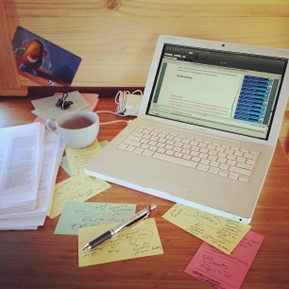

Editing: The Basics |
||||
|---|---|---|---|---|
Overview of Editing
This is where it starts getting hard. Use your favorite grammar/text editor: Grammarly, Pro-Writing Aid, etc. You don't have to agree with it all the time, and we suggest you don't, but look at it from an outside perspective. You can even turn off some suggestions, based on your writing style
|
Getting StartedSo you've put your manuscript down for 30 days, right? Right? We're serious, you better take this step. Now you are ready to edit. Make a clean copy of your manuscript. If you will have issues not correcting things on the computer, print it out. Once again, I am very serious about this. Okay? All right, let's go.  "I've found the best way to revise your own work is to pretend that somebody else wrote it and then to rip the living shit out of it."
|
If you're doing this on the computer, it's time to make some decisions. Turn on your track changes. If you're doing this on paper, you don't have to. Now decide on your favorite grammar program. Grammarly, Pro-Writing Aid, etc. Many word processors are already plug-in ready. Turn it on and let's go. Now it's going to return a lot of things for you to look at. Don't get overwhelmed. Set a timer and work through each suggestion. Some will be easy, some won't. Some will require a later response, and some you will turn off. This is where it is helpful to know your genre and audience. This is also where a lot of people get bogged down. Take it easy on yourself, but be objective. I know, I know, it's hard.  By this time, you should know where your story falls apart. Especially if you look at the outline you made earlier. Now is when we start fixing the story. Write those scenes you're missing. Add to scenes where necessary. Move other scenes. Make a mess and then fix it. Your manuscript may have a million little comments and suggestions to work through. Write the scenes, or even rewrite them if necessary. This should feel like fun, I swear. Go back to step one. Rinse and Repeat. Though, try to limit this to 3 or 4 times. At some point, it's time to get someone else's eyes on it. |
||
What Are the End Goals? |
||||
 Is this next step the right one for you? Could be. Could also be peer revision? It's time to think about what is your end goal for this manuscript. Depending on what you want, it could go to Beta Readers. Could go to a Developmental Editor. Or even a Copy Editor. Remeber, beta readers are free. Editors will expect to be paid. |
 Is it time to look for an agent? Or start sending query letters? If you have gone through beta readers/peer review/developmental editing, it's time to talk about shopping and possibly selling your manuscript. |

The ultimate question. Should you pursue a traditional publishing contract? Or should you self-publish the manuscript? And how does one do that? Only you can decide which way to go. Base your decision on how you feel about your story and your manuscript. |
||
Things to Remember |
||||
|
Set a timer. Editing can be overwhelming. Only work for an hour or half hour at a time. Stand up. Take a walk. Then sit back down. Don't be afraid to rewrite an entire scene. We do this a lot. Sometimes we get something better. Sometimes we don't. Sometimes we combine revisions. Don't be afraid to read out loud. Hearing it helps. |
 "Every morning, we choose between milk or tea or coffee. Usually, I know what I like, but I don't rule out changing my idea sometimes.
The editing process is one of the most important parts in everyday life. The same with my work: mistakes are a part of the decision-making process."
|
So now you have to decide, am I ready for the world to read this? If the answer is yes, then move on to beta readers. It's always a good idea to get other eyes on your manuscript before you prepare to publish. The best eyes are fellow writers who have experience with critiquing and publishing. |
||
Copy Editing |
||||
|
I look for both consistancy in wording and characterization. If you use "leapt" in one spot, you should use it throughout your manuscript. If your main character is known to have a nervous tick, they should have that tick throughout. If your character stands in one paragraph, then stands again a little later on the page, they had better sit somewhere inbetween. This is one of the biggest issues I run into. A lot of writers, particularly newer ones, like to head hop. They move from one character's point of view to another. This is okay in "ominicient third person narrative," but more often than not, it ends up confusing the reader. It's better to stick to one point of view (usually per chapter, or section), where you focus on what the one character thinks/feels/observes. If your character can't observe what another character is doing, don't include that information. |
This is the heart of my editing. I will be looking for typoes, missing words, too many words, and unnecessary words. Keep in mind, if a character picks up a knife, it's assumed they used their hand, unless you've established they can pick up the knife some other way (prehensile tail, psychic powers, etc.). You don't have to say "with their hand." When someone stands or sits, you don't need to say "up" or "down" because when people stand, it's usually up, and when they sit, it's usually down. Again, unless you establish a rule which goes against the norm, you can leave out what would be normally understood. I also look for words used too often in one sentence/paragraph. For example, if you say, "He opened the door, and went through the door, closing the door behind him," I would edit this to be, "He opened the door, stepped through, and closed it behind him." All those doors aren't necessary. Finally, I will be draconian about the use of "that" and "had." Both of these words are largely unncessary and removing them doesn't change the meaning of the sentence. Taking them out usually makes your writing more concise. Most "that"s can go, and "had" should be used if you really mean something happened in the past, or someone has a posession (in which case, you can switch up the word used). If I see "that that" or "had had," we're going to have a talk. Tense is another area where I see a lot of problems. If you're writing in past tense, keep it there. Present tense, the same. Third person works best with past tense, and first person works best with present tense, but use what you find most comfortable, just be consistent. |
While Maeghan Jo Kimball may go more in depth with flow, I will point out when something doesn't seem to be in the right place. Sometimes dialogue doesn't flow right, because the conversation in your head sounds different than the one on paper. Sometimes actions don't make sense, because the reader isn't seeing what the author is imagining. I will point out these areas. As for staging, words paint pictures, and it's important you paint a complete picture, showing where people are standing and moving in relation to one another. If people are across a large room from one another, can they hear what each person is saying? I've read books where people should have been shouting at one another, but they were whispering and somehow were still heard. Think about space, think about what your characters can observe (this is especially important when it comes to point of view), and think about movement. |
||
Developmental Editing |
||||
Here is a PDF copy of the flyer for download - Editing: The Basics
If you would like to schedule a workshop on this or another writing topic, please Contact Us!
|
Feral Writer's Club Copyright 2024 All Rights Reserved |
About FAQ Contact Us Join |